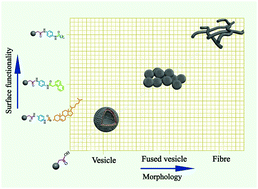Self-assembly of surface functionalized amphiphilic carbon dots: tuning in morphological manifestations†
Abstract
Despite the continuous surge of interest in supramolecular chemistry, the design and synthesis of building blocks to develop diverse examples of self-assemblies is still challenging. During the past decades, formation of self-assemblies such as micelles, vesicles, and gels with a fibril network using amphiphiles has been investigated at length. Considering the increasing applications of these self-aggregates across the scientific domain, it is crucial to adopt an alternative strategy for the preparation of self-aggregates using a new building block that has been applied in diverse domains. With this aim, surface functionalized carbon dots (CDs) with varying aliphatic/aromatic (cholesteryl, palmitoyl, naphthyl) substitutions linked with spacers such as ethylenediamine, p-phenylenediamine, 2,2′-(ethylenedioxy)bis(ethylamine) were developed. The surface passivated CDs formed self-assemblies in dimethylsulfoxide-water (DMSO–H2O, 2 : 1, v/v). The roles of surface functionalities and spacer units in the formation of self-assemblies using the synthesized CDs were investigated by microscopic and spectroscopic studies. Progressive morphological transition was found from vesicle-to-fiber in DMSO–H2O (2 : 1, v/v) which was dependent on surface passivating substitutions of the CDs from cholesteryl to naphthyl to palmitoyl. Together with the exclusive formation of self-assemblies using amphiphilic CDs, the present study enabled the tuning of self-organization behaviour of the CD by alteration of its surface functionality.



 Please wait while we load your content...
Please wait while we load your content...